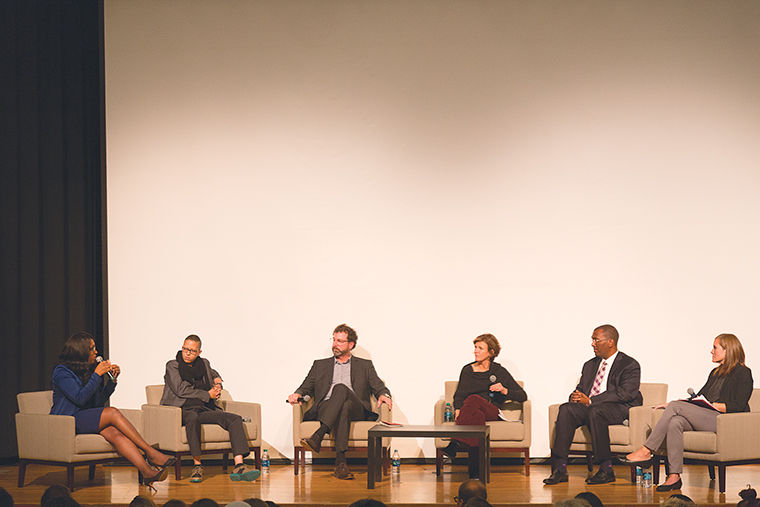Can a more welcoming police station bring cops and residents together?
As part of the Chicago Architecture Biennial, a panel discussed the reimagined police station designed by Studio Gang called Polis Station. It is named after the Greek word for a tight-knit community and it is the root word of police.
November 23, 2015
A panel of architects, building commission members and real estate developers discussed redesigning the North Lawndale police station to foster a better relationship between police and residents as part of the Chicago Architecture Biennial on Nov. 17.
Jeanne Gang, founder of Studio Gang—an architecture, interior and urbanism practice in New York and Chicago—presented the “Polis Station,” named after the Greek word for a tight-knit community. The proposed, redesigned police station, which for now is a conceptual proposal, features a community center with a community meeting place, shared athletic amenities and more.
Gang, a recipient of a MacArthur “genius grant,” also designed Columbia’s Media Production Center, which was built in 2010.
The panel included Felicia Davis, director of the Public Building Commission in Chicago and a former police officer; Mitch McEwen, an architect and designer who works out of Detroit and New York; Scott Plank, executive director of War Horse, a real estate development firm; and Ghian Foreman, executive director of the Greater Southwest Development Corporation on the South Side and civilian member of the Chicago Police Board.
The panelists and moderator Gia Biagi, senior director of Civic and Urban Impact at Studio Gang, discussed the would-be impact of the Polis Station.
Gang said nationwide calls for police reform led to discussions of creating Polis Station. “Polis Station seeks to contribute to this dialogue by exploring how design can help people imagine changes in police and community relations by taking a close look at the police station and the architectural space it has become over the years—in many communities it has become a jail,” Gang said. “This project hopes to offer ideas to help transform urban spaces into neighborhood investments and ultimately strengthen the community in return.”
Gang said her studio chose the North Lawndale police station because they were familiar with the area and crime that occurs there frequently.
Gang said the studio received funding to build a basketball court in the North Lawndale station parking lot from the park district and through private funding after presenting the design.
Davis said that when she worked as an officer in the Englewood neighborhood, an ATM was relocated to the inside of the police station because many people were getting robbed at outdoor ATMs in the ‘90s.
She said it was revolutionary because it brought people to the station for a non-police-related function. She said people also often visit the station during the winter and summer to warm up or cool off.
During the panel, an audience member raised the question of whether a mere building would solve the disconnect between police and community members.
“[The building] has to be a part of it and the relationship goes hand in hand with the building itself,” Foreman answered.
Plank agreed that the redesigned building would help build relationships between the community and police officers, but said a drastic change must come from policy.
“The building can be a tool for the policy to change, and we also know when the building looks like a fortress, regardless of the policy, you are going to have less comfort walking toward that building.” Plank said. “The building [and] the rooms are just tools, but [something] has to happen at a policy level, and hopefully we are supporting the strategy to make a change.”
Foreman said the design would allow residents to see officers in a natural environment doing everyday things like getting a haircut or picking up dry cleaning . He said by allowing the community to see this side of officer’s lives community members would be better able to relate and establish healthy relationships with them.
“It’s still not a welcoming place,” Foreman said. “It’s never going to be welcoming, but we can make it more welcoming.”
Megan Baker and Maria Pia Jimenez, both students studying design at the School of the Art Institute of Chicago, said they found the panel discussion interesting.
“It also makes you think, as a citizen, of how you can claim those spaces,” Jimenez said.
They said they enjoyed the panel and agreed that the design is a starting point for a change in community and police relations.
“I wished they had talked more about police brutality…. It was like they wanted to, but they were shying away from actually talking about it,” Baker said. “You can’t resolve a problem without saying it’s a problem.”
Jimenez said the station could be a place for police and community members to come together to address issues like police brutality.
Polis Station is currently on display at the Chicago Cultural Center, 78 E. Washington St., until Jan. 3.








